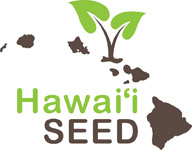Hawaiian Papaya: GMO Contaminated (2006)
In 1998, the first GMO Papaya was commercially released into Hawaii’s growing environment. Dr. Dennis Gonsalves and Dr. Richard Manshardt created this papaya ringspot virus (PRSV) resistant GMO fruit and were experimenting with its release in PRSV ridden Puna, the main papaya growing area of Hawaii. While the GMO Papaya is resistant to papaya ringspot virus, it brought many more problems than it solved. The GMO Papaya has closed lucrative export and organic markets and always has a low price point. This technology has come with too many strings attached and Hawaii has lost almost half of its papaya farmers.
Another unintended problem is GMO contamination. In 2003, GMO Free Hawaii became very concerned with the gene flow of the GMO Papaya. First, we used the GUS gene test to see how much contamination was on our farms and in our community. After consistently finding 30-50% of the seeds and leaves we tested having some kind of air or seed contamination, we wanted to know more. We put out calls for independent, peer-reviewed academic studies to examine the levels of this GMO Papaya contamination, to no avail. In 2004, GMO Free Hawaii designed a study to look at the extent of GMO contamination around the state.
The methodology of this Pilot Survey included three composite samples of approximately 10,000 seeds from around the islands (Hawaii, Oahu, Kauai) being collected from non-GMO growing locations such as organic and conventional farms, backyard gardens and feral roadsides. Two composite samples each of seeds and leaves from organic farms were collected on Hawaii and Kauai. Three samples of University of Hawaii non-GMO seed varieties were purchased directly. Seeds and leaves were sent to an independent laboratory, Genetic ID, for PCR (Polymerase Chain Reaction) industry standard testing.
The results indicate massive GMO contamination of papaya seeds on Hawaii Island, of the order of 50%, substantial GMO contamination on Oahu (<5%) and thankfully, only traces of contamination on Kauai (0.0%). Both organic farms tested had no GMO trees unintentionally planted, but sadly, were discovered to have air contamination of the seeds in their fruits (<5% on Hawaii Island and 0.01% on Kauai). Most shocking was the GMO contamination of the University of Hawaii’s non-GMO papaya seed supply (Waimanolo Solo variety) at greater than 0.01% but less than 0.1%.
